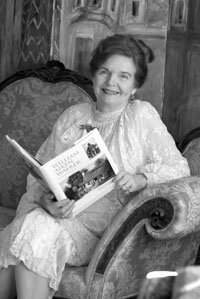FACETIME- Found art: Toledano resurrects forgotten painter

Roulhac Toledano
PHOTO BY JEN FARIELLO
When art historian Roulhac Toledano first came to know the work of painter William Aiken Walker in 1968, she found that while his Reconstruction-era paintings of life in the deep rural South predated her, they were immediately familiar.
"I grew up in west Texas, and everywhere there were ranches that grew cotton," she explains. "I remember seeing the migrant workers pulling bolls, and they looked just like these paintings."
So for four years she drove from North Carolina to Florida to Louisiana– and everywhere in between– trying to track down Walker's paintings for her book, William Aiken Walker: Southern Genre Painter.
"There were some in museums, but a lot of them were just in people's attics," she says. "They weren't worth anything then. Even the bigger ones were worth only about $400."
Then Toledano shifted her focus to architectural history. With her husband, in 1983, she bought Charlottesville's "pink warehouse," a structure that would become home to various artists including a youthful Dave Matthews.
Although Toledano had consigned Walker's art to the dustbin of her own personal history, New Orleans-based Pelican Publishing tracked her down in 2005 with a bit of news.
"They told me that Walkers were selling for anywhere between $25,000 and $45,000 at auction and that they wanted to re-publish," says Toledano. "I thought, 'Oh my God, I don't even own my own copy of that book!'"
After two years of examining newly discovered works by the South Carolina artist– as well as sifting through the inevitable forgeries– the 69-year-old Charlottesvillian has brought Walker, who died in 1921, back to life for art lovers the world over. The new, expanded edition of her book is published this month.
As she has become reacquainted with her old subject, Toledano says the reasons for the renewed interest in Walker remain a mystery to her.
"It could be that the South has money now," she says, "and that these paintings are the most honest depictions of a time and place not many others were painting."
As in the early '70s, Walker's work can still provoke controversy. Some scholars have derided his images of poor African-Americans hoisting cotton bales and dressed in tatters as cartoonish and racist. In Toledano's view, however, Walker intended no such message.
"He was just painting what he saw," she says. "He grew up poor in Charleston, and most of the people he knew there were black. If you look at photographs from the era, that's exactly what they look like.
"I've even had Africans view these paintings," she continues. "They look at them and say, 'Oh, that's a Yoruba, that's an Ebo.'"
Toledano's editor at Pelican, Nina Kooij, says scholars have long been pleading for a reissue of the book on Walker.
"He's become a significant painter in our region," says Kooij. "It's such a wonderful opportunity to reproduce his works with this kind of quality."
Not resting on her Walker book, Toledano now finds herself hard at work on two new projects. She reports that she's received some interest from publishers in a biography of François Coty, the Frenchman who first mass-produced women's cosmetics. And she's in the thick of research for a history of New Orleans architecture.
"Now that they're rebuilding New Orleans after Katrina, it's important to look back," says Toledano. "All the buildings that stuck to the height and scale of what's tried and true there survived."
Toledano will be honored at a reception celebrating the republication of her book at Blue Whale Books on Thursday, January 17, at 5pm.
#